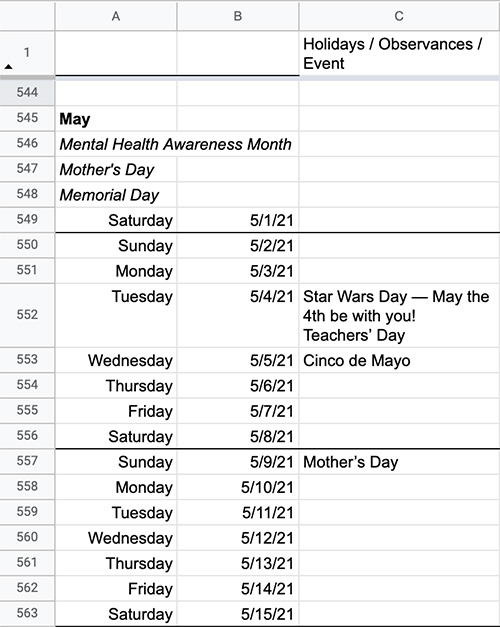Happy New Year! It’s time to start strategizing for the next 12 months if you haven’t already. While this may sound daunting, it’s just a matter of following a series of steps. Here’s how I do it for my small business clients.
1. Create a spreadsheet with a row for every day.

I am an avid Google Sheets user because we can edit them concurrently and they’re always up-to-date. Make one column for the date, duplicate it, and change the format to “day of the week”. Then add lines between Saturday and Sunday so you can see where each week ends.
2. Add themes and holidays.
Between each month, create a space and add the name of the new month with general themes like “Spring”. Then add major holidays and shopping events like Black Friday. I also like to add super fun ones, like Star Wars Day, and ones that are relevant to my client’s industry, like National Hot Tea Month.
3. Duplicate past successes and learn from losses.
This is the most time-consuming but important step. If a campaign performed well, I add it to the schedule and figure out how to optimize it more.
If a campaign didn’t perform well, I try to figure out what didn’t work in case I can salvage the idea.
- If an email had a low open rate, it might have had a poor subject line or got caught in spam filters.
- If it had a high open rate and low clickthrough rate, it’s likely the body of the message didn’t match what people were expecting from the subject line.
- If it had a high open and clickthrough rate but poor conversion, I comb the website analytics to see where people dropped off. It may point to usability issues.
4. Add campaigns to a calendar with reminders.
I create calendar events with email reminders so I have a visual representation of the task in my inbox. I schedule monthly check-in meetings with clients to review what worked in the past month and finalize our plans for the next three months.
5. Share it with the team.
Since the marketing calendar is in a spreadsheet, we can create sheets for each channel and import them into a central spreadsheet for a comprehensive overview. I share spreadsheets with paid search and social teams for a holistic marketing message.
6. Track your progress.
As the days roll by, all the marketing teams add analytics to the spreadsheet so we can observe trends in real time. That makes it easy to see if a Free Shipping promotion worked better than 15% Off, and we can adapt future campaigns with the winning strategy.
Customers revisit old emails, sometimes weeks after the original send date, so open rates increase gradually over time. For the truest comparison, pull analytics the same number of days after each send.
Share your planning tips in the comments. As always, feel free to reach out to me with questions. I’m happy to chat!




